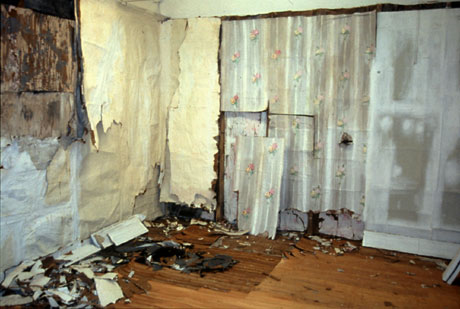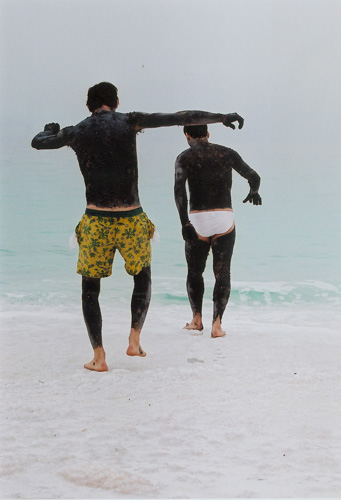
Valerie Hegerty Renovation (2002) paper, cardboard, paste, paint, 8' x 14' x 14'
As soon as I walked into Valerie Hegarty's studio I thought I'd died and gone to heaven.
My reaction may have been rather singular, because even I was not surprised that some visitors to her part of Smack Mellon's Open Studios weekend decided her workspace was an empty room not quite swept up yet. This was one of the confidences she shared with Barry and I last night.
But I was immediately at home, or rather immediately taken back to a previous home. At the same time I had the impression that the two successive, long-term creative passions of my life had somehow been reconciled: the recovery of a domestic architectural and social past, and an immersion in the visual art of our time.
Hegarty builds new, lovingly-assembled, homely environments, out of paper, paste and paint, which uncanily evoke the decaying remnants of, well, old, neglected, homely environments.
The real stuff has a power over me because it appears to be both untouched and touched very much, even too much. There's wear, lots of wear, and it looks fantastic, very purposeful and above all very human. Hegerty's imaginary recreation of such (ephemera?) is obviously stimulated by a great love of and serious commitment to the spell of such (almost) spent human environments. The product of her art raises to a level just this side of the sublime what once could only be part of the real world.
I crept about the studio half holding my breath, but then, when we both introduced ourselves to the artist, we were soon even more intrigued than before. I'm afraid we ended up monopolizing her attentions unfairly.
I told her about my fascination with the unselfconscious physical dignity of old buildings and with their previous lives. My interest began when I moved to grad school in Rhode Island, and it quickly became something of an obsession. Feeding such a passion was easier in the period I was there, 1964-1985, since I was able to crawl into abandoned townhouses, mills, churches, warehouses, shops and farms still undisturbed by modern remodeling, "restoration" or arson. I was like entering long-abandoned Egyptian tombs.
In those days architectural artifacts were regularly tossed as trash, even in neighborhoods already being "discovered." During that time my partner and I were able to save one modest eighteenth-century house from disaster. Disguised in filfth and layers of paint, wallpaper, flooring and siding, sweat and imagination eventually made it look like it had only been heavily worn during its 250-year life. And then we each abandoned it, ultimately to owners who would love it but never know the joys of our own discoveries along the way.
Hegerty's creative response to that environment came much later, and from a very different direction. Also a New Englander, she grew up in Massachusetts, but her own parents' home, faux-colonial, could only sadly reference the integrity of its sturdy, hoary neighbors. Plastic ornament stood in for the kind of artifacts I saw thrown to the trash pickups.
But wonderful art followed.
One of the treats we were able to walk away with on Thursday was the revelation that she has been working with playfull storyboards to (perhaps) move, into the dimension of film, an aesthetic which even now is hardly limited in the way it provides enjoyment. Her art works as both realism and abstraction, both painting and sculpture. I stopped for a moment to imagine a delightful projection of flesh and blood people appearing in, disappearing into and altering her remarkable synthetic environments. More magic.
The Open Studios continues tomorrow, from noon to 6pm.
If you miss it, you have another chance to see her work very soon. Hegerty is one of twelve artists selected to create site-specific environments in the show, "Playpen," opening at the Drawing Center on Wednesday. I wouldn't miss it for the world, especially as the list of artists also includes Charles Goldman, Austin Thomas and Gedi Sibony.
[image, of an instalation not in the studio of course, from Smack Mellon]


